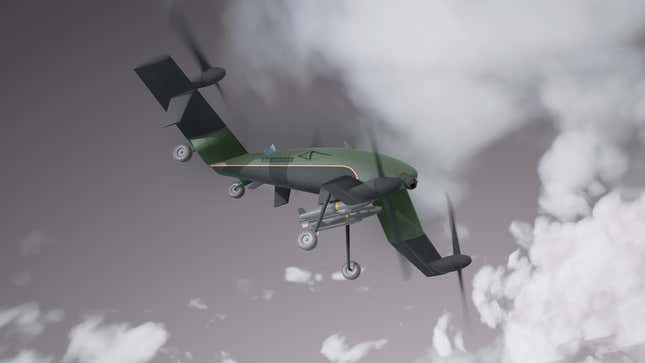
Nearly 120 years into the history of modern flight, I did not expect biplanes to make a comeback in drone form. Yet the STRIX, from the Australian wing of defense giant BAE Systems, is exactly that. What’s more, this odd duck of a biplane drone is a tailsitter, resting on its wheels at an angle so it can launch vertically, fly level, and then gently angle its posterior back to the ground before landing.
Spotted by The War Zone late in February, the STRIX had its formal debut as a concept at the 2023 Avalon Airshow in Geelong, Australia, earlier this month. With four engines, two sets of wings, and a body that looks like the toy version of something snake-themed COBRA would send against GI Joe, it is, at minimum, an eye-grabbing concept.
“STRIX is entirely new. It’s a new concept. We’ve virtualized a tiltrotor aircraft and we uniquely combine the capabilities of vertical take-off and landing before transition to conventional flight,” said Ben Hudson, CEO of BAE Systems Australia, in a video announcement. “STRIX has been created because we saw a gap in the market, and what we’re trying to do is, with STRIX, meet the needs of the future battlefield.”
Amidst the jargon and the sales pitch, what the STRIX appears to offer is a drone that can fly from mostly anywhere. Militaries have deployed ship- and truck-launched drones before, but those technologies often depend on a special rail launcher, which positions the drone at an angle for easier takeoff. The ScanEagle, one such scouting drone used by the U.S. and other countries, can take off from a runway or a rail, and requires catching by net or skyhook to retrieve after flight.
That’s a lot of extra infrastructure to carry around with a drone, and while it reduces the space needed to launch and fly, it doesn’t allow for vertical take offs. In 2015, ScanEagle makers Insitu even demonstrated a special oversized quadcopter mothership, to lift the drone up in the sky and launch it from the quadcopter’s belly.

To obviate the need for extra equipment, and to allow launches from a helipad or possibly smaller, the STRIX is a tail-shitter. Tail-sitters have a long history of a long history of attempts in the vertical takeoff space. One of the biggest hurdles for making such a plane work is the strain it would put on an onboard pilot. The crewed planes that ultimately did work in vertical takeoff form did so as either tilt-rotors, like the V-22 Osprey, or ducted jet thrust, like the Harrier and the F-35B. DARPA, the blue-sky project wing of the U.S. military, is exploring how to make fast takeoff vehicles operating without runways work from a blank slate.
Without the need for an onboard pilot — and the troublesome problem of human skulls that must be protected against rapid changes in position and thrust — a tail-sitter drone is free to function within the bounds of aerodynamics, rather than biology. (This, too, is something explored by DARPA.)
The STRIX is designed to solve that problem through both tail-sitting and also autonomous takeoff.
“The platform ideally will be operated as a predominantly autonomous system most of the time. Take-off and landing and the transition from vertical to horizontal flight will be fully autonomous,” said Mic Crump, principal technologist for autonomy for BAE Systems Australia. “Autonomous technologies aren’t intended to replace the human in the modern battlefield, but rather to augment them.”

To make the STRIX useful to the humans commanding it, it is designed to have a range of nearly 500 miles while carrying 350 pounds of payload. This can include sensors and communications relays, as well as bombs or missiles. With a human operator remotely guiding the drone, autonomous systems can handle the basics of flight while a human controller would be expected to make the important decisions. The airframe of the STRIX is designed to fit into a shipping container, and launch upon assembly once wheeled out.
One reason Australia and the United States are so interested in planes that can launch without runways is the expectation that, should a war be fought in the Pacific and against China, such runways will be hard to maintain and secure. (This war planning often, though not always, focuses on the operational problems of supply and repair, without spending too much time factoring the risk of nuclear exchange cutting short such a war with apocalyptic fury). In order for a campaign to work from the island chains of the Pacific and any land beyond that, being able to operate armed drones from cleared fields and helipads expands how the war can be effectively fought, instead of relying on paved and reinforced 6,000-foot stretches of runway.
For now, STRIX is a concept, though a prototype is in development, and BAE claims the drone could be ready to enter service as soon as 2026.
Watch a video of the STRIX concept below:
